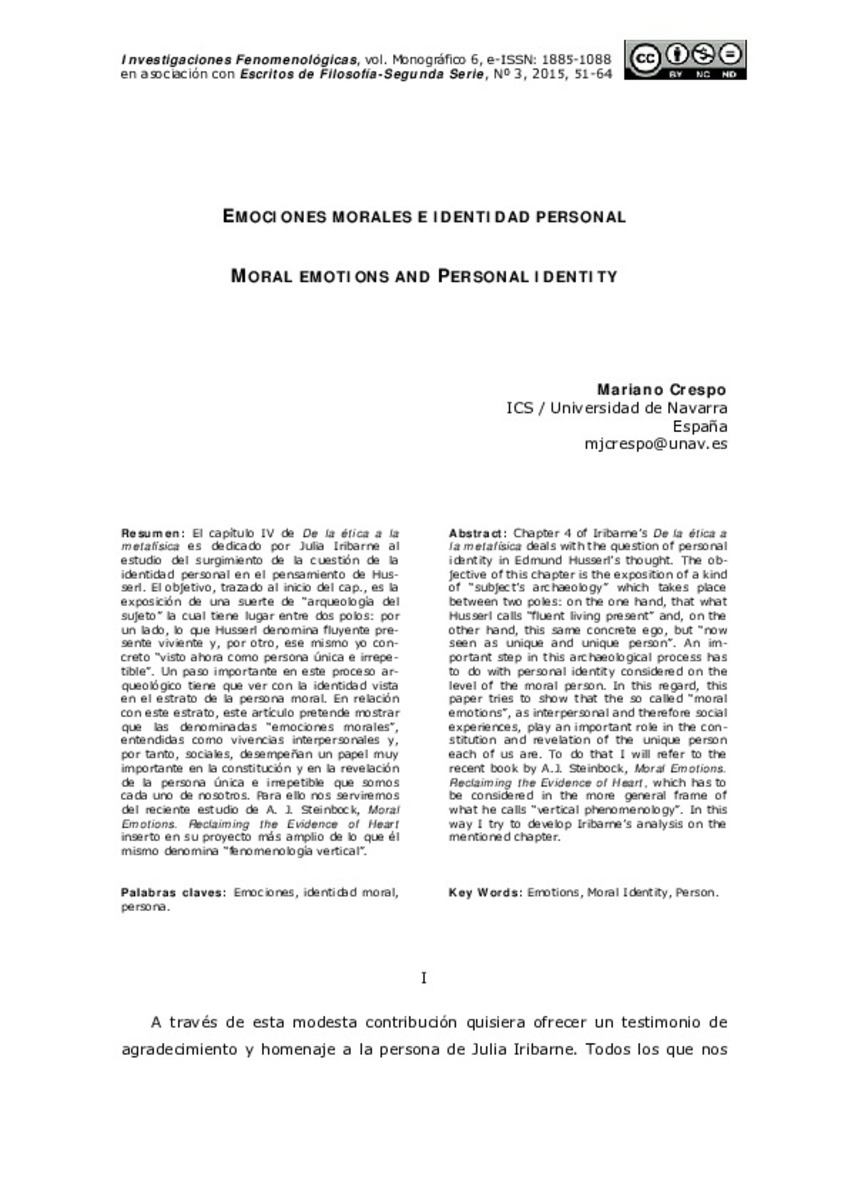Full metadata record
| DC Field | Value | Language |
|---|---|---|
| dc.creator | Crespo, M. (Mariano) | - |
| dc.date.accessioned | 2020-03-30T11:58:03Z | - |
| dc.date.available | 2020-03-30T11:58:03Z | - |
| dc.date.issued | 2015 | - |
| dc.identifier.citation | Crespo, M. (Mariano). "Emociones morales e identidad personal". Investigaciones Fenomenológicas. 6 (3), 2015, 51 - 64 | es_ES |
| dc.identifier.issn | 1885-1088 | - |
| dc.identifier.uri | https://hdl.handle.net/10171/58915 | - |
| dc.description.abstract | El capítulo IV de De la ética a la metafísica es dedicado por Julia Iribarne al estudio del surgimiento de la cuestión de la identidad personal en el pensamiento de Hus- serl. El objetivo, trazado al inicio del cap., es la exposición de una suerte de “arqueología del sujeto” la cual tiene lugar entre dos polos: por un lado, lo que Husserl denomina fluyente pre- sente viviente y, por otro, ese mismo yo con- creto “visto ahora como persona única e irrepe- tible”. Un paso importante en este proceso ar- queológico tiene que ver con la identidad vista en el estrato de la persona moral. En relación con este estrato, este artículo pretende mostrar que las denominadas “emociones morales”, entendidas como vivencias interpersonales y, por tanto, sociales, desempeñan un papel muy importante en la constitución y en la revelación de la persona única e irrepetible que somos cada uno de nosotros. Para ello nos serviremos del reciente estudio de A. J. Steinbock, Moral Emotions. Reclaiming the Evidence of Heart inserto en su proyecto más amplio de lo que él mismo denomina “fenomenología vertical”. | es_ES |
| dc.description.abstract | Chapter 4 of Iribarne’s De la ética a la metafísica deals with the question of personal identity in Edmund Husserl’s thought. The ob-jective of this chapter is the exposition of a kind of “subject’s archaeology” which takes place between two poles: on the one hand, that what Husserl calls “fluent living present” and, on the other hand, this same concrete ego, but “now seen as unique and unique person”. An im-portant step in this archaeological process has to do with personal identity considered on the level of the moral person. In this regard, this paper tries to show that the so called “moral emotions”, as interpersonal and therefore social experiences, play an important role in the con-stitution and revelation of the unique person each of us are. To do that I will refer to the recent book by A.J. Steinbock, Moral Emotions. Reclaiming the Evidence of Heart, which has to be considered in the more general frame of what he calls “vertical phenomenology”. In this way I try to develop Iribarne’s analysis on the mentioned chapter. | es_ES |
| dc.language.iso | spa | es_ES |
| dc.publisher | Sociedad Española de Fenomenología (SEFE) | es_ES |
| dc.rights | info:eu-repo/semantics/openAccess | es_ES |
| dc.subject | Emociones | es_ES |
| dc.subject | Identidad moral | es_ES |
| dc.subject | Persona | es_ES |
| dc.subject | Emotions | es_ES |
| dc.subject | Moral Identity | es_ES |
| dc.subject | Person | es_ES |
| dc.title | Emociones morales e identidad personal | es_ES |
| dc.title.alternative | Moral emotions and personal identity | es_ES |
| dc.type | info:eu-repo/semantics/article | es_ES |
| dadun.citation.endingPage | 64 | es_ES |
| dadun.citation.number | 3 | es_ES |
| dadun.citation.publicationName | Investigaciones Fenomenológicas | es_ES |
| dadun.citation.startingPage | 51 | es_ES |
| dadun.citation.volume | 6 | es_ES |
Files in This Item:
Statistics and impact
Items in Dadun are protected by copyright, with all rights reserved, unless otherwise indicated.






